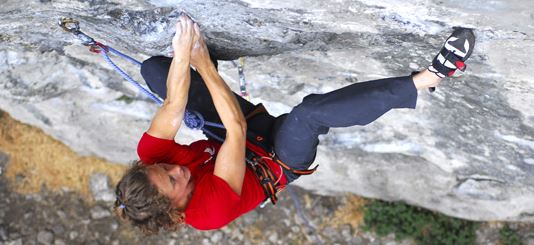Choosing the right rock shoes
Getting the right rock shoe is essential. You can leave behind your harness, chalk bag, belay device or even your rope - you'll probably still get some climbing done. Forget your rock shoes (previously called 'rock boots') and you'll be scrabbling around in misery.

How is a rock shoe constructed?
Surprisingly, many rock shoes are still made by hand (La Sportiva, Boreal) in Western countries. Whilst this might mean a higher build quality it is also what can sometimes lead to inconsistencies in shoe size within brands and even within shoe types. It also explains why they might be considered expensive by some.
What are the types of rock shoe construction?
Board lasted
The sole of the boot is made stiffer through the use of an insert, this makes for a more supportive shoe that is good for edging. This is the traditional way that boots were made but it's expensive and other ways have been found to stiffen slip lasted boots.
Slip lasted
An inner sock is made from the upper material and this then has a rubber sole glued onto the outside. Traditionally this made the shoe more sensitive and meant you could feel more through the boot. It also meant you needed stronger toes to support your body weight.
Whilst this is still often the case with slip lasted shoes there are also now many slip lasted boots which are stiff. These slip lasted boots will never retain their stiffness as well as proper board lasted shoes, but they are pretty close. By handling a few pairs of rock shoes and talking with staff in a shop it's easy to tell the difference between the varying levels of stiffness of slip lasted shoes.
There is a third type of shoe that is slip lasted but has a unique 'banana' shape. These are shoes which have a very pronounced hook or downwards point to the toe. They work by creating tension between the toe and heel which keeps your foot in a downwards pointed position that encourages you to climb more on your big toe. This is more useful on over hanging territory.
Which shoe for which rock?
Stiffer boots like the Silex Velcro and Anasazis are generally preferred for climbing on slate or steep limestone. For any routes that are long regardless of their rock type you'll want something stiff and comfortably shaped like the Five Ten Gambit. Softer soled shoes like the Katana and the Joker are generally favored for gritstone or any rock type where you have to do a lot of smearing.
Lined or unlined?
Rock shoe uppers are made from fabric, synthetic leather or real leather (which is still the most popular). Leather stretches the most of the three, especially across the width of the boot. For this reason leather boots are sometimes lined. This lessens the stretch but does not eliminate it completely. All shoes will stretch a little even those with synthetic or fabric uppers. Shoes will only stretch very slightly lengthways due to the sole and the rand of the shoe.
Laces or velcro?
The advantages of velcro shoes are they tent to be easier to get on and off, especially in a hurry. For a more precise fit, lace shoes are still the best option.
How much do rock shoes stretch?
Unlined leather shoes stretch the most. Other than this the amount that shoes stretch seems quite arbitrary. Synthetic boots supposedly do not to stretch, but often do. In a good climbing shop the staff will know which boots stretch to what degree as they will have had feed back from people about the boots they sell. Another reason to buy from a reputable climbing store with knowledgeable staff.
Sole shape?
Most rock shoes are slightly or very asymmetrical, bringing your toe and the curve of your foot inwards. The more aggressive and asymmetrical it is the more technical and uncomfortable (but not unduly so) it will be. Shoes with soles that are shaped like your foot will obviously be much more comfortable and you'll be able to wear them all day but they will not perform quite as well as an asymmetrical shoe when it comes to standing on really small holds or climbing overhangs.
Which type of shoe do I want?
If you are a beginner then you will probably want to try board lasted shoes first. They are generally more comfortable and also tend to be slightly tougher with thicker soles that will last longer (when you start climbing it's possible to wear out thinner shoes quite quickly due to imprecise footwork). Once you've owned one or two pairs of rock shoes you will know if you want to try a different type. The absolute rule of thumb with rock shoes however is buy what fits. If you happen to be buying your first pair of shoes and the only pair that fits and feels good is a super technical pair in a disgusting colour then so be it. Fit rules, every time.
How long should I spend trying on rock shoes?
Belief that you have the best shoes on your feet and that they'll stick is half the battle when it comes to climbing. You need to trust your boots to stay put. Don’t feel bad about dwelling in depth on your choice of boots and taking your time buying. It's not unusual for people to take an hour to choose a pair of rock boots.
Where can I try on rock shoes?
Outside of course! Britain's best mountain shops have a range of shoes, with good stock of all the sizes, good testing facilities and knowledgeable staff. That's what Outside has to offer. Shopping online? email us at [email protected] for extra information on the rock shoes.
What should I consider when it comes to fit?
Trying on a large variety of different shoes in a shop, testing the shoes and talking to the staff will mean a better fitting shoe.
Shoe size
Normal shoe size is just a start. Every brand has a different sizing system. A size nine in one make could be a size seven in another.
Your foot shape
Generally, different brands suit different foot shapes. If you have worn a shoe that fitted you made by one manufacturer, chances are that other shoes made by the same company will also fit you.
Tightness
Pain is pointless. Don’t fit your boots too tight. Apart from the pain caused by your shoes being too tight, you won't be able to smear effectively which could be highly limiting. In times gone by it was suggested that your boots should be so tight that your toes were turned into a claw or a talon and massively bunched up at the end of your boots. One day it is possible that you might want a really tight pair of boots, but you will know when that day arrives. As a rule it is best to go for a snug fit not a tight fit.
Socks
It's personal preference whether you wear socks with your climbing shoes. Most people don't as they feel they will lose sensitivity and feel (Dave McLeod has climbed E11 with socks on under his climbing shoes so it can't slow you down that much). If you do wear socks under your climbing shoes then make sure you've got the socks you intend to wear with you when you try on a new pair.
Soft shoe
A softer shoe will need a slightly tighter fit than a board lasted shoe. Your foot is providing the rigidity here and this will be difficult to achieve if the shoe is too loose.
Baggyness
Check for air pockets in the shoe that you notice climbing or just walking around. Does the heel 'fart' when you walk? the shoes may not fit correctly if that is the case.
When to try on rock shoes?
Don’t try on boots after you've been out climbing all day. Your foot will have swelled making it too sensitive to judge whether something is comfortable or too tight. In the morning your foot is smaller than in the afternoon. The best time to try on boots is in the afternoon on a day when you've not been climbing.
Buying rock shoes online?
When buying online it is a good idea to order two pairs, a half size difference to compare. If unsure speak to a member of staff on the phone or email [email protected] for excellent impartial advice.
The Rubber Debate
There is much debate about which shoe maker has the best and stickiest rubber. A large number of climbers regard FivTen 'Stealth' rubber highly. It is safe to say that the rubber of all the boots sold at Outside is of high quality and if cleaned properly, extremely sticky. Getting an accurate of boot rubber comparison is difficult and based on conjecture, hearsay and personal perception.


